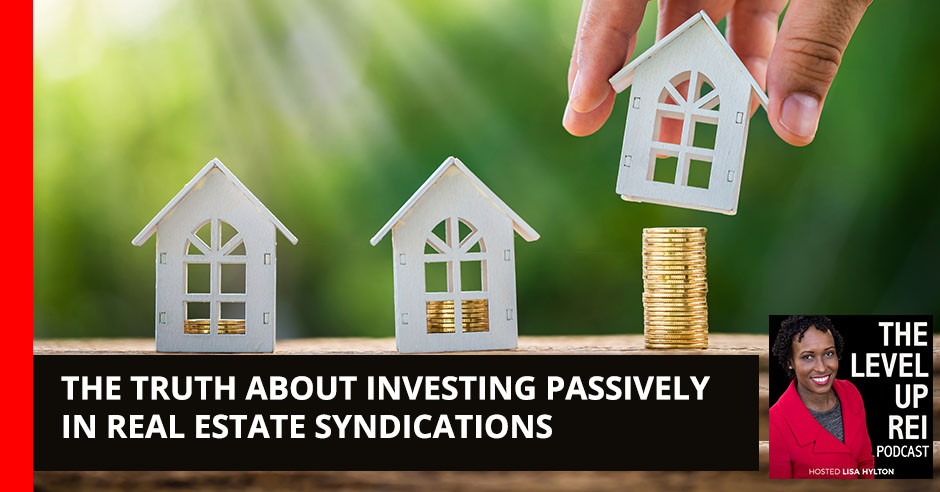
Real estate syndications are one way of letting people pool resources to invest in asset classes they couldn’t invest in before. However, people often don’t have a deep understanding of syndications. Lisa Hylton shatters the misconception by giving us the truth behind it. Lisa looks at several facts and gives us the lowdown on why real estate syndications work. Tune in to learn more as you walk the path of financial freedom.
—
Watch the episode here
Listen to the podcast here
The Truth About Investing Passively In Real Estate Syndications
Welcome back to another episode of the show. I’m doing a solo episode, and this episode’s topic is the truth about investing passively in real estate investments. I decided to do a show on this topic because I find that a lot of the things that I’m going to talk about in this episode are things that I continue to have conversations with investors as I talk to them about investing passively and wanting full transparency as well as further education about the process. There are ten of them, so let’s get started.
The first one is investing passively in real estate syndications. By and large, for most irregular investors who are investing anywhere between $50,000 to $100,000 is a multi-year process. Even if you did have $1 million, $2 million, and $5 million all at one time to invest now, chances are it still would be a multi-year process because you’re going to spend time getting to know different sponsors and through that, getting to know different markets and asset classes to then get comfortable about where it is that you’re putting the money and where you want that money to go.
You can deploy all of the capital potentially the next day, but most people are going about it to first get educated about the process, deploying it, seeing how it works with this particular sponsor, and then deploying more and then going from there. That’s the first. It’s a multi-year process. When I say multi, I would say that from doing my show for the past few years now and I’ve had several passive investors. It’s not a whole ton of full-time passive investors, but a lot of them are full-time passive investors. Number one is Jeremy Roll. You can find his episode in the archives of my show. It took him close to ten years of consistently passively investing in a variety of different real estate investments.
He also invested in non-real estate investments as well, like businesses, but it took him roughly ten years to achieve that. I believe that he was also investing every single year on top of your initial investment because if you’re going to wait for your initial investment, think about it. Most deals are anywhere between a 3 to 5-year hold, and most are trying to achieve a 2X on your money, so if you invest $50,000, they’re trying to get to $100,000 in 3 to 5 years, and then you do the process again into another deal with a 3 to 5-year hold with the goal of doubling your money during that time. Let’s also be honest, which is one of the other items in here, but sometimes, things don’t always go as planned, and I will get to that.
Item number two is investing in turnkeys and joint ventures, and being a general partner on these syndications is not passively investing in real estate syndications or in real estate. Airbnb, turnkeys, and all those different strategies come with higher potential return or cashflow, as well as if you’re flipping potentially a big payout, but you’re also doing more. You’re active. You’re not not doing anything at all, which is the situation when you invest in these passive deals.
No one can completely predict the future. We are all doing the best we can. When investing, whether in real estate, the stock market, or cryptocurrencies, you're always taking a risk. Share on XWhen you invest, you’re not doing anything more. The people who are running the deal are responsible for executing the business plan and ensuring the returns are achieved. Joint ventures, once again, are also active. They’re not passive. All the people should be involved in some way in order for it to be a legal joint venture agreement.
Truth number 3, the most important aspect of the deal is a sponsor team. This might be controversial for some people, but you can have good assets in good markets, but if you have it in the hands of a team that doesn’t understand or know what they’re doing, mismanagement and etc., or you can have the perfect environment in terms of where the deal should be able to perform, but it doesn’t perform because you have a team that doesn’t know what they’re doing and ultimately, could lose your money, and investors’ money.
I have met people who have lost money in deals. Luckily, the six that I’ve invested in have not come into that situation, but there have been instances where deals have underperformed, but I have not lost my money. It’s super important. Truth number three, the most important aspect of the deal is a sponsor team. It’s taking the time to get to know the sponsors, who are asset managing the deal, what is their experience asset managing, is this a wash, rinse, and repeat situation, or are they executing this for the first time. It’s not that you don’t invest because they’re executing this for the first time, it’s that you are managing your expectations and you’re going in with your eyes wide open about the process and what it is that you’re choosing to do.
Item number four is that there are many deals. This is the truth about investing in real estate passively. Meet sponsors, take the time to get to know people, take the time to get to know markets, asset classes, and whatever you need to do to make sure that you’re comfortable before you decide to deploy your capital.
The fifth truth is no one has a crystal ball. No one can completely predict the future. We are all doing the best that we can. When you invest, be it in real estate, stock market, cryptocurrencies, or whatever, you’re always taking a risk. What I recommend, even for myself as I look to deploy capital into different deals, is I’m looking at the risks involved in this particular investment and how we are going about mitigating these risks, like the risk of the deal not performing as well as it should? One of the risks that I discussed before is the sponsor team, so it is very important to understand their track record and experience executing these types of deals in the past. That is truth number five.

Real Estate Syndications: There are many deals. This is the truth about investing in real estate.
Truth number six is not all deals go as planned, which I touched on a little bit earlier. Even with the best teams and the best markets and asset classes, I think that it’s important for investors to diversify. Diversify across sponsors, markets, and asset classes because we’re all doing the best that we can. COVID is a great example in the sense that no one could predict that this was going to happen, so at the moment, you’re doing the best that you can and you move from there.
The sponsor teams that you’re working with there, you want them to be responsive and that they’re going to think outside of the box, be creative in terms of being able to continue to manage the asset, and make the right decisions for both themselves as well as the investors in the deal. Connected to this point is that as an investor, it’s important to be up-to-date with market trends or market economic data, so reading information about the CVRE or Marcus & Millichap and understanding.
I’m not a big news person, I’ll be completely honest, but at least getting the big-ticket items that are going on and understanding what’s going on in some of the markets that you’re interested in investing in can help you to make better decisions, because then, you’re more knowledgeable about what’s going on. That’s truth number six.
Truth number seven is the general rules of thumb can change. I’ve taken a lot of different courses from a lot of different groups over the years. I’ve been exposed to this and doing this for a little bit. As the material ages and as I continue to be in conversations with many of them, I’ve seen where things change in terms of what they anticipate a rent increase is going to be in the 1st year versus 2nd second year, 3rd year, expense reductions, and other stuff like that.
What I’ve learned is the following. It’s not that I don’t care about the rent increases or the expense reductions, etc., but what I care about more is how you get comfortable with projecting this assumption, and the assumption being rent increases of X, Y, Z amount in year 1 versus year 2 and 3, and listening to what the answer is to that.
Investing in real estate is slow and stable money, by and large. Share on XSome of the things that I want to see and look for is that they’re providing things like CoStar reports for similar properties and vintages in the market that are showing rents that are higher than what is at the current subject property as well as other properties that they have in their portfolio that are in the same type of area, similar vintage, similar year built, similar style, and similar type of demographic in terms of people. That helps me to say, “This makes sense in terms of where rent is going,” because the reality is you’re dealing with what is going on in the market now.
On the expense side, as more and more operators build out virtually integrated companies, I believe that they have the ability to have a more streamlined expense process in the sense that they’re able to then have economies of scale because they have multiple properties in that particular area, which then enables them to better be able to win deals because, for them, it might not cost them as much to run a deal because they have multiple deals in that particular area. That is something that I’ve learned with time, and to be open to and continue to see and go from there.
The eighth truth is if you think that you want to be active, one of the best ways to do so via the passive investing track is to network with sponsors, so you can find situations where you can earn while you learn. I did an episode with K. Trevor Thompson. In his episode, he was all about earning and learning. He had invested in close to over ten different syndications. During that time, he looked for sponsors. He actively looked for sponsors when he invested as a passive investor. He could also be involved in asset management even if he wasn’t necessarily getting paid any of the asset management fees, but he was able to assist with the asset management process in order for him to continue to grow and develop that skill.
Also, being boots on the ground. Maybe moving to Dallas, Austin, or any of the other markets that are out there, moving to those markets can help in the sense that if you are then working with sponsors that are playing heavily in that area, you could say, “I would love to be a part of boots on the ground,” and to go from, go from there, but the idea is that you can move into the active role through passively investing, but the way you do that is by finding sponsor teams and telling them this is what it is that you want to do and seeing is there an ability to add value in that way and if they’re open to it. You never know until you have the conversation.
It’s important to have the conversations and to take it from there, but let people know that this is what it is that you want to do, and then the sponsored teams that are not interested in that are going to be like, “We don’t offer that for our investors. They’re strictly passive and they’re not involved in our operations.” They’ll let you know, and then that way, you can then make a decision whether you want to go through with them or not.

Real Estate Syndications: It’s important for investors to diversify across sponsors, markets, and asset classes.
Another interview I did was with Masha, a self-storage investor. It was an interview that aired maybe two episodes before K. Trevor. She also talked about how when she was looking to get into her first passive investment in the self-storage space, she specifically looked for an operator that was willing to allow her to not only invest as an LP but be involved and learn because she wanted to be more active. That’s another truth in all of this as well.
Truth number nine, passively investing in real estate is slow and stable money by and large. If you’re looking for heavy-duty cashflow, be it buying properties and doing the Airbnb strategy or Airbnb short-term rental arbitrage, which is renting properties and then putting them on a short-term rental, it has the ability to generate a lot of cashflow very quickly.
When it comes to passively investing in real estate syndications and these items, I would say this is very patient money, in my opinion, especially if you decide to invest in opportunities that are opportunistic in nature, like development deals or big deals that don’t have a lot of cashflow, but are anticipated to have a big pop 3, 4, 5, 6, 7, 8, 9, or 10 years from now.
I would say when you’re investing passively in these real estate syndications, it has the ability to build with time, but in the beginning, it’s slow and stable money. It’s something to think about as you’re deploying capital and thinking about where it is that you are in your journey. Some people are still in the heights of their career, they’re CFOs or VP of Finance, all these different jobs, and they’re making significant amounts of money, they don’t necessarily need the cashflow now, but they might be investing.
They would like to be able to see that their money grow double or triple, or if they’re investing in all the things and would like to 10X their money, I would say that understanding where you are in the trajectory can be very important in terms of choosing the types of deals that you decide to put your money into.
Last but not least, the last truth is that plugging into networks of other investors is critical for your growth as well as continuing to learn and understand a variety of these deals. You don’t necessarily need to find a network to plug into. You can create your own if you’d like. Tuning into my show, for instance, you’ll notice that there are so many different people that I’ve had on the show. If you want to reach out to any of them, you can. By doing that, reaching out to them and building those relationships enables you to create your own community.
Through building a relationship and friendship with some of these people, you could probably even share, like, “Have you worked with this sponsor before? What are some of the things that you’re seeing? Have you invested in this particular market?” Stuff like that helps you to not only see the theoretical stuff like the Marcus & Millichap report, CPRB reports, etc., but you’re also talking to other investors who might real-time be investing in similar sponsors as you or even similar markets. They might be living there or just investing.
Whatever the case is, it enables you to then be able to have that network of people that you can reach out to and get support and help from. To wrap up, these were my ten truths for investing passively in real estate syndications. I hope that it’s brought some insights for you, some clarity, and maybe even different perspectives on things to think about. Until next time, have an awesome day.
Important Links
- Jeremy Roll – Previous Episode
- Trevor Thompson – Previous Episode
- Masha Klapanova – Previous Episode

Recent Comments